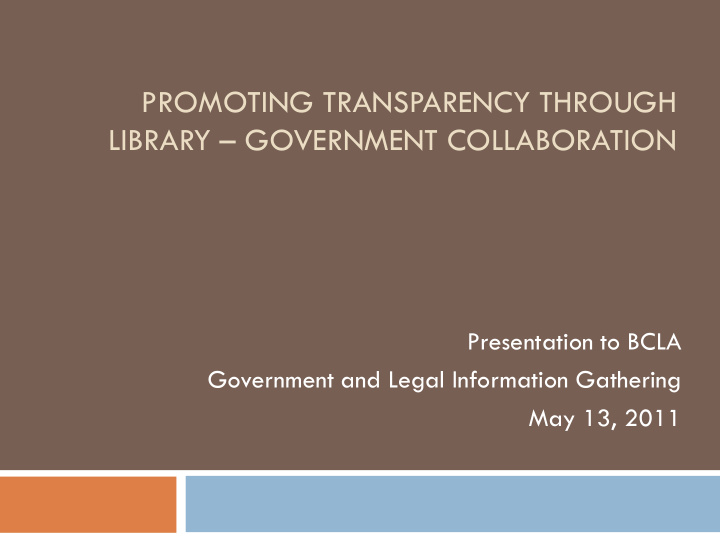



PROMOTING TRANSPARENCY THROUGH LIBRARY – GOVERNMENT COLLABORATION Presentation to BCLA Government and Legal Information Gathering May 13, 2011
Agenda GATT Digital Library - project history Libraries as agents of government transparency
Research question How does membership in international organizations influence the politics and policies of member nations? How did membership in GATT/WTO influence 1. the creation and power of free-trade coalitions in its member countries? How did membership in GATT/WTO influence 2. the trade policy decisions of member countries?
Library resources What were Stanford’s Library holdings in 1995? GATT Depository (1952) – 2% of documentary output Basic research collection What else could be acquired? Expanded secondary literature collection Microfiche subscription program “for libraries” – 10% of documentary output Comprehensive microfiche documents “for governments” collection
Overcoming the restriction problem Librarian visits GATT in Geneva and discovers microfiche collection for governments available only to GATT member delegations Professor Goldstein seeks US Congressional approval to obtain delegate status Congress informs U.S. Trade Representative (USTR) in Geneva that Stanford should have access to all GATT and WTO restricted documentation Under aegis of USTR status, Library acquires microfiche collection for governments Library staff divide collection into ‘public’ and ‘restricted’ components
More information gaps References to GATT documents “looseleaf schedules” not found on microfiche. Questions about organization, about membership, and legal status of agreement not answerable from material on microfiche March 1999 Study Trip findings: An apparently unique set of Looseleaf Schedules located in Market Access Division A unique collection of bound tariff round negotiation documentation in a locked room Documentation in the microfiche collection for governments is not comprehensive – 85-90%? Archival practices at the organization are uncoordinated
Toward collaboration March 1999 . Team (scholar, librarian, technologist) visits WTO. Confirms scope of problem and interest on part of WTO in a role for Stanford in enhancing preservation of and access to historic GATT material. April 1999 . Findings reported to University Librarian. May 1999 . Memorandum of Understanding between SUL/AIR and WTO signed. June 1999 . Agreement with WTO signed. July 1999. Scanning begins. 30 students, 6 technology staff, 2 archivists, 2 preservationists State of the art scanners and computers
Agreement key terms Preserve material not already preserved on microform Maintain confidentiality of records according to WTO requirements Shared intellectual property in the records Digitization operation: No off-site scanning Scanning operations limited in time to summer recess Copy of all records provided to WTO
Goals Preserving the Historical Record at WTO Digitize over 2 million pages of GATT/WTO unique archival source material, documents, photographs, and publications. Enhancing Access & Ensuring Preservation Develop digital repository, metadata, navigational tools, and searchable World Wide Web interface. Creating Conditions for New Knowledge Record oral histories Compile statistical databases
Confidentiality Three levels of access specified in Agreement Public (general public) Restricted (GATT contracting party/WTO member) Confidential (WTO division staff) Stanford Special Collections policies serve as model Metadata for all preserved records and documents contains “access” field
Targeted collections Archival Sources (on-site capture) Central Registry Archives, External Relations Division Division Archives (Legal Affairs, Market Access, Accessions, etc.) GATT Director-General Files (Peter Sutherland, Arthur Dunkel) WTO Director General Files (Renato Ruggiero, Michael Moore) Photographic Archive (on-site capture) Documentation Various series not on microfiche (on-site capture) Conversion of microfiche (IMLS-funded) Publications Certified Protocols (IMLS-funded) 1964 Tariff Study (on-site capture)
Confidence-building Culture of extreme discretion – 2 factors requirements of successful trade negotiations national perspectives on public’s right to know
Results Completed digitization 12 sources 90 diverse, representative collections 2.2 million page images, 600 photographic images Built public interface Conditions for new knowledge Built trusting relationship with WTO staff Encouraged transparency impulse
Import? Libraries can become trusted partners with governmental organizations to capture history and encourage transparency The interest of Libraries in broad collecting has signficiant value for providing context and understanding
Recommend
More recommend